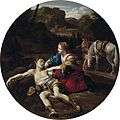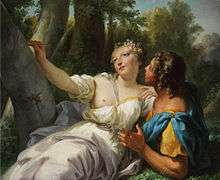Angelica and Medoro

Angelica and Medoro was a popular theme for Romantic painters, composers and writers from the 16th until the 19th century.[1] Angelica and Medoro are two characters from the 16th-century Italian epic Orlando Furioso by Ludovico Ariosto. Angelica was an Asian princess at the court of Charlemagne who fell in love with the Saracen knight Medoro, and eloped with him to China. While in the original work, Orlando was the main character, many adaptations focused purely or mainly on the love between Angelica and Medoro, with the favourite scenes in paintings being Angelica nursing Medoro, and Angelica carving their names into a tree, a scene which was the theme of at least 25 paintings between 1577 and 1825.[2]
List of artists depicting Angelica and Medoro
- Nicolas-Sébastien Adam, Angélique et Médor, 1753
- François Boucher, Angelica and Medoro, 1763
- Ludovico Carracci, Angelica and Medoro, two heads
- Eugène Delacroix, Angelica and the wounded Medoro, c. 1860
- Angelica Kauffman, The Loves of Angelica and Medoro
- Teodoro Matteini, after a design by Raphael Sanzio Morghen
- Marcantonio Raimondi, Angelica e Medoro, after Giulio Romano
- Joshua Reynolds, Angelica and Medoro
- Bonifazio Veronese, Angelica e Medoro
- Benjamin West, Angelica and Medoro, 1763–1764
- John Wootton, Landscape with Angela and Medoro, in the Royal Albert Memorial Museum in Exeter
- Mihael Stroj, Angelika und Medor, (1833), a scene from the epic Orlando Furioso
Gallery
-

Simone Peterzano, Angelica and Medoro, before 1596
-

Jacques Blanchard, Angelica and Medoro, 1630
-

Giovanni Lanfranco, Angelica nurses Medoro, before 1647
-

Lanfranco, Angelica and Medoro, 1633–1634
-

Sebastiano Ricci, Medoro and Angelica, c. 1720
-

Tiepolo, Angelica and Medoro with the Shepherds, 1757
-

Jean-Baptiste Bénard, Angelica and Medoro, before 1789
-

René Théodore Berthon, Departure of Angelica and Medoro, c. 1810
-
.jpg)
Angelica and Medoro, 18th century (artist unknown)
List of authors writing about Angelica and Medoro
- Francisco de Aldana (1537–1578), Medoror y Angélica, describing their adventures after the end of the Orlando Furioso
- Luis Barahona de Soto, Primera parte de la Angélica (1586), also describing the adventures after the ending of the Furioso
- Lope de Vega, La hermosura de Angélica (1602)
- Luis de Góngora, En un pastoral albergue, 1602, depicting the honeymoon of Angelica and Medoro
- José de Cañizares, Angélica y Medoro, 1722
List of composers writing about Angelica and Medoro
Libretto by Andrea Salvadori
- Jacopo Peri and Marco da Gagliano, Lo sposalizio di Medoro e Angelica, 1619
Libretto by Metastasio
- Nicola Antonio Porpora, Angelica e Medoro, 1720, which marked the debut of Farinelli
- Giovanni Battista Mele, Angelica e Medoro, 1747
Libretto by Leopoldo de Villati
- Carl Heinrich Graun, Angelica e Medoro (3 acts, 1749)
Libretto by Carlo Vedova
- Giovanni Battista Lampugnani, Angelica e Medoro, 1738
- Giovanni Battista Pescetti, Angelica e Medoro, 1739
Libretto by Gaetano Sertor
- Gaetano Andreozzi, Angelica e Medoro, 1791
Other
- Vito Giuseppe Milicco and Domenico Cimarosa, Angelica e Medoro, 1783, a cantate
Notes
- ↑ Waid, Candace (1991). Edith Wharton's letters from the underworld: fictions of women and writing. UNC Press Books. p. 29. ISBN 978-0-8078-4302-4. Retrieved 6 October 2011.
- ↑ Littlejohn, David (1992). The ultimate art: essays around and about opera. University of California Press. p. 111. ISBN 978-0-520-07608-2. Retrieved 6 October 2011.
Further reading
- Julius A. Molinaro, Angelica and Medoro; The Development of a Motif from the Renaissance to the Baroque, 1954
- Rensselaer W. Lee, Names on trees : Ariosto into art, Princeton University Press, 1977, 124 pages, ISBN 0-691-03914-3.
| Wikimedia Commons has media related to Category:Angelica and Medor. |